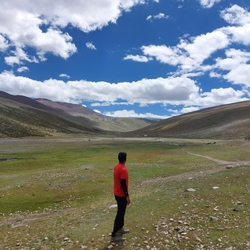Did you know that the Vikings and Romans used crampon-like equipment to move around in snow or ice covered regions? Yes, the concept of crampons is really that old! Crampons make movement on ice and snow more secure and are an essential part of climbing and mountaineering gear. They are used for crossing glaciers, ascending snowy slopes and climbing ice walls. A crampon typically consists of a metal frame with spikes which is attached to the boots for greater traction on ice and hard snow.
This article provides all the information pertaining to crampons, including its types, parts and functions. We have also dropped in a few tips for storage and maintenance which could prove to be handy!
Different Types of Crampons
Step-In Crampons: A highly specialised type of crampon used for mountaineering and ice climbing. They offer a tight fit, giving the feeling that they are an extension of your feet and not a separate piece of equipment attached to the boots. They sit firmly in place with the help of metal bars and rubber welts on your boots. Step-in crampons can only be used with certain kinds of mountaineering boots that have the rubber welts for the crampon to be attached properly.
Hybrid Crampons: These are the less specialised and more flexible variant of the step-in crampons. These have become more popular and are also preferred for general mountaineering. The heel setup in the hybrids is similar to the step-in crampons which holds the boots securely in place and offers a tight fit. The hybrids however have a strap to pull the crampon into place instead of a metal bar. These are suitable for covering more ground but are not effective on technical and steep terrain. Hybrids are compatible with a wide range of boots.
Strap-On Crampons: These are less technical but the most common type of crampons. Strap-on crampons can be slipped over the boots and are held in position with adjustable straps.They do not require rubber welts or metal bars to attach them to the boots, thus making them compatible with almost all hiking boots. They are lighter, cheaper and easy to use when compared to the step-in or hybrid crampons. They cannot be used for more technical activities and are limited to walking on flat and maybe less angled surfaces.
Parts of a Crampon
There are two major parts to a crampon with six components in total. The two parts are the binding system and the base of the crampon. The binding system consists of a heel clip, binding straps and a toe cage while the base of the crampon consists of flexbar, spikes and anti-balling plates.
Flexbars: Also known as the linking bar, the flexbar allows for the length of the crampon to be adjusted depending on the size required. It is a semi-rigid component of the crampon.
Anti-Balling Plates: These are also known as antibott plates and can be found on the underside of the crampon. A crampon has two anti-balling plates and a flexbar which connects the two. The main function of these plates is to prevent snow from accumulating under the crampon, which will add weight and render them useless for climbing purposes.
Spikes: This is the part of the crampon that provides traction. The spikes are attached to the anti-balling plates at the toe and heel of the crampon. Spikes on a crampon can be modular or non-modular. Modular crampons come with spikes which can be removed and changed based on the need. They are suitable for people who do a lot of mixed climbing. The non-modular variant comes with spikes which are permanently fixed as a result of which they gradually wear out over time. However, their permanent fixture makes them more sturdy and less likely to break. Predominantly, crampons come with 10-12 spikes which are laid out in 3 ways. Mono-point crampons have a single spike in the front and are suitable for highly technical climbs, dual-point crampons have two spikes in the front which create a secure platform and are suitable for ice climbers, and horizontal point crampons have two short horizontal spikes in the front and are suitable for most mountaineering expeditions.
Heel Clip: This part of the crampon goes around the heel to hold it securely over the rear end of the anti-balling plate. It is a key part of the binding system and keeps the foot in position.
Binding Straps: These help attach the crampons to the mountaineering boots. The step-in variety have a cable heel piece and a lever that are adjustable to fit the boot. They also consist of a toe bail to fit on the front welt of the mountaineering boot. The hybrid variety involves a combination of toe strap that fits boots which do not have welts and a cable heel and lever system that attach to the heel. The strap-on variety are used with mountaineering boots that have no welts. They consist of adjustable straps to attach the crampons to the boots and also hold them in position.

Function of a Crampon
Crampons are key traction gear in mountaineering which provide heightened security and reduce the risk of falls or similar accidents. They also improve the climbers mobility in snow and ice, which could otherwise be difficult in mountaineering boots. Snow and ice make the surface slippery and more difficult to traverse. The use of crampons provides the much needed grip over these surfaces, thus giving the climber a strong hold to move forward.
How to Attach Crampons to your Boots
- Adjust the flexbars to suit the size of your boots.

- Adjust the heel clip to a correct height for a secure fit. Find a heel clip position that offers a secure snap without any added tension.

- Adjust the straps to hold the crampons in places. If your heel clip is in the perfect position, it should hold your crampon in place without the binding straps. Check before adjusting the straps and continue to fix your straps in a manner that offer a snug fit around your boots.

Crampon Care, Maintenance and Usage
Like all other mountaineering gear, crampons require care and maintenance from time-to-time. This will ensure that they are in good condition and do not take you by surprise with a malfunction during an expedition.
- Always check the bindings prior to an expedition. Inspect for loose screws, worn out straps or buckles and replace based on requirement. Check if the fit between your boots and crampons is secure and perfect. Always carry spare parts and a wrench during your expedition in order to fix the crampon if needed.
- Crampons spikes need to be sharpened after use, particularly if they have been used on rock. Use mill files and file the sides and points as sharp as possible. A straight line must be maintained from the frame to the tip. Ensure that the filing is done in the direction of the file’s teeth. In case of any bent points, straighten them before use.
- Sharp spikes make for better crampons on delicate terrains but can also cause cuts in your skin, clothes and rope if not packed properly. Use rubber point covers or padded crampon cases to avoid cuts and tears.
- Ensure that your crampons are fully dry before storing them. Store them in a cool dry place. For long term storage, coat the crampons with light oil to avoid rusting.
That’s pretty much all you need to know about crampons! Should you have any further questions regarding this piece of mountaineering equipment, our team is available to answer and resolve your doubts.






